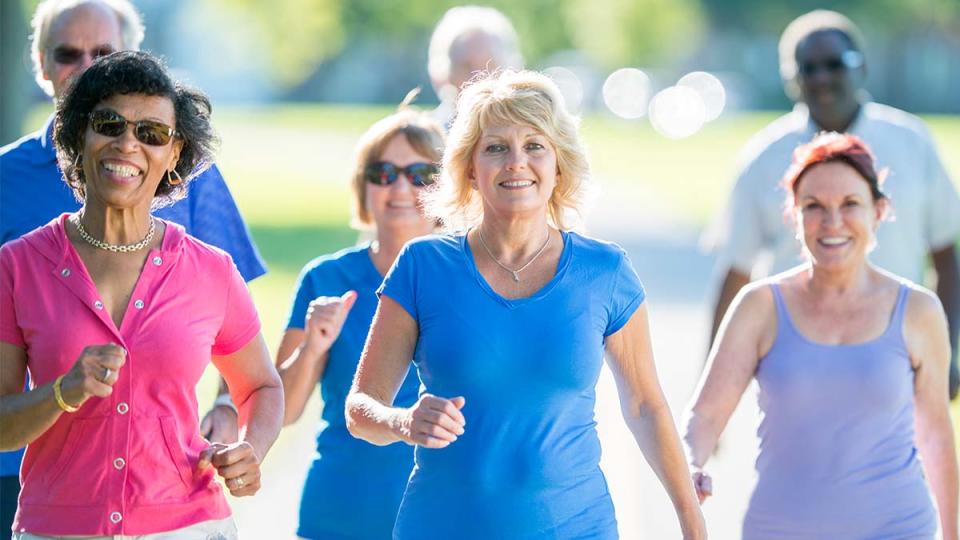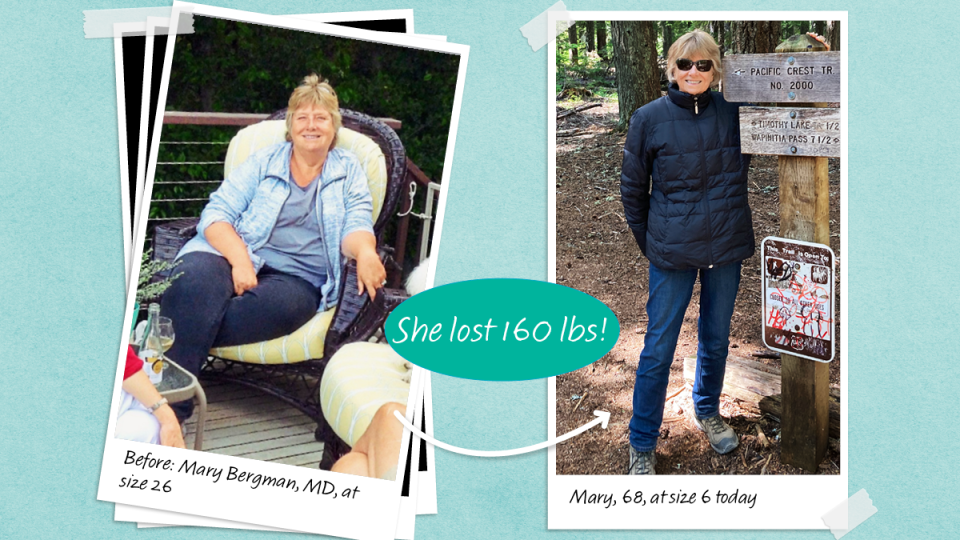Studies Prove Group Walking Is Even Better at Boosting Weight Loss — How Your Health Can Benefit
Recently, we’ve heard a lot about the many health factors that can be contagious…everything from germs and viruses to the gut bugs we share with our family members. Now research shows that exercise — and the health benefits it brings — can be contagious too. Enter the growing trend of group wellness walks. As it turns out, group walking can be more effective than solo walking for achieving our weight-related goals.
“One of the pillars of health is socialization,” says retired physician Mary Bergman, MD, who lost weight after joining a walking group and has kept it off for years. (See her amazing success story below.) She adds, “We know that healthy eating helps with longevity, but so does socialization exercise. It’s one of the very top things that affects our health and lifespan.” Here, everything you need to know about making group walking work for you.
Why walking is so good for you
For starters, walking is one of the healthiest activities people can do, universally recommended by most doctors. And walking in a group setting is even better. An analysis of more than 40 studies confirmed that people walking in groups reduced their body mass index and body fat. They also lowered their blood pressure, resting heart rate and cholesterol.
“Walking is a social exercise like no other," says Dr. Bergman. "You engage with your environment, your friends and your body, all at the same time. The conversations are endless. It’s the best way to network.” Here are the top reasons that make group walking really work...
How group walking boosts the benefits
In an Australian study, women were more likely to want to go walking if they saw other women doing the activity. Lead researcher Kylie Ball, PhD, professor at the School of Exercise and Nutrition Sciences at Deakin University, agrees that group exercise is contagious. “Seeing other people engaging in exercise can send the message that doing so is positive, socially desirable and beneficial — as well as fun.”
So if you’re the type of person who needs a kick-start, she adds, “Women can use this to their advantage by joining an exercise group, forming their own or even just engaging a friend or family member as a walking buddy.”
The social element keeps us committed
While we all know how easy it is to skip a workout, the accountability in a group helps us continually show up. In fact, researchers found that compliance for group fitness classes was as high as 98.8%, compared to 35% among those who adhered to a fitness plan alone. Cardiologist David Sabgir, MD, puts it this way: “If I know Janet is waiting for me at 8:30 by the pavilion to walk, I can’t miss it.”
Is group walking better than solo walking?
Compared head-to-head, group walking beats solo walking, hands down. “With social exercise, you walk longer and farther than you walk by yourself, and you will walk more often,” says Dr. Bergman. Simply put: “If you have a walking buddy, you will do better!”
Walking with others makes the time go faster, adds Dr. Bergman. “You’re paying attention to other things and talking to friends, and all of a sudden, Oh, my God, we’ve done 5 miles. It’s more than just walking. When you are with the group, it’s also the time you spend together, it’s the growth you get, it’s uplifting. You are laughing, and if you were by yourself, you wouldn’t be laughing.”
In Dr. Ball’s research, she found, “While most people joined a group walking program initially for health benefits, many stayed for the social aspects.”
Group walking also delivers big health benefits

When we walk with a partner or group, we get bonus benefits that incentivize us to keep slipping on our sneakers day after day. Here's just a few of the perks...
1. Social support cuts cravings
A new UCLA Health study finds that women who perceive themselves to be socially isolated exhibit more brain activity linked to food cravings and overeating.
2. Group exercise boosts mood
In one study of stressed-out people, those who exercised in group settings felt their stress levels significantly drop and experienced increases in physical and emotional well-being.
3. Group walking helps us lose weight — and keep it off
Volunteers in one study who had group support from friends were more likely to complete a four-month weight loss plan than those going it alone. And 42% more people in the friend group maintained their weight over 10 months than those who lost alone.
Real-life proof: Virginia Harmon, 71, shed weight by cleaning up her diet and taking a partner — either her friend or spouse — on all her walks. She also received coaching and support from Lisa Asbell’s Well Weight Loss program. Virginia lost 2 pounds every week and a total of 93 pounds in a year. Plus, her friend lost 45 pounds and her husband lost 30! Now Virginia takes around 14,000 steps every day! (Learn how weighted walking, or rucking, helps with weight loss.)
4. Walking strengthens women’s bodies
Hitting the pavement improves bone strength, wards off weight gain associated with menopausal hormone flux, eases hot flashes and reduces breast cancer risk.
Related: How Indoor Walking Helped My Menopause Symptoms
5. Group walking beats loneliness
Retired Harvard political scientist Robert Putnam, PhD, extensively researched the loss of community in our modern, high-tech world, leading some experts to call it a “crisis of loneliness.” Dr. Sabgir, a cardiologist, confirms, “Unfortunately, 60% of us in the U.S. are lonely, and surprisingly, that carries a toll on our health that’s equivalent to smoking 15 cigarettes a day.” The good news: “Not only do we feel better when we join others walking, it plays a significant role in improving our health.” He adds, “I’m fortunate to come across quite a few success stories. One of my favorite things: I see women getting together outside of their group walks for other activities that keep them socially connected.”
Health experts even prescribe group walking
Given all these health and weight-loss benefits, it’s no wonder health experts are promoting and even "prescribing" the group walking trend. When Dr. Sabgir noticed his patients not taking his advice to walk more, he took action. Dr. Sabgir founded Walk With a Doc, public meet-ups in which people can walk side by side with a physician and other community members.
The program is now available in more than 500 communities in the U.S. and more than 40 countries. The camaraderie of the walk-and-talk model has helped 93% of participants feel more empowered to live a healthy lifestyle.
All that activity is helping women shed pant sizes, get stronger, ease joint pain and improve blood work. Dr. Sabgir says, “I’ve seen many people decrease or get rid of their diabetic or bloodpressure medications by walking.”
Try group walking for yourself with these tips
• Don’t delay
Dr. Sabgir says, “My general prescription for using social walking for health and weight loss would be to start today.” He cites Marisa Franco, PhD’s book Platonic, on the science of social attachment, which emphasizes how happy others are to be invited to do something. So Dr. Sabgir encourages, “Text a friend today with a walk invite.”
(Learn about walking while you work with under-desk treadmill benefits.)
• Aim for 150+ minutes a week
Yes, start today, but start slow. The general goal is to walk 150 minutes weekly. Dr. Sabgir says, “If you’re not there yet, or even close, you shouldn’t worry. You’ll absolutely get there. I recommend building by about 10% a week.” He adds, “If new to the game, give yourself plenty of patience. And take comfort in knowing you are on the exact ‘path’ you need to be on.”
Group walking success story: Mary Bergman lost 160 lbs

Ugh, I just don’t want to take these stairs, thought Mary Bergman, MD, dreading the five steps that separated her from the upstairs of her home. Unless she was sleeping, she was in pain, particularly in her knees and ankles. She reveals, “I wanted to participate in life, and I couldn’t.”
Several times over the previous decades, Mary had lost and then quickly regained more than 100 pounds. She admits, “Being an MD, I was thinking, I should know better.” So once she retired, she looked for ways to truly feel better.
Mary tweaked her eating habits. She ultimately ditched her processed diet for one focused on whole-food, plant-based meals with no added sugar, salt or oil. She found recipes and inspiration from “Plant-Based with Jane Esselstyn and Ann Esselstyn” on YouTube. (Another helpful resource is Caldwell Esselstyne MD’s book Prevent and Reverse Heart Disease.)
After cleaning up her diet, Mary joined a walking group
As the weight melted off, Mary’s resolve to get healthy only grew. After losing 130 pounds, she finally felt ready to join the vibrant walking group of women in her new, tight-knit community. “I was nervous. I didn’t know if I could keep up with them,” she recalls. “But when you lose weight, you have to find a new way to meet up with friends that doesn’t involve calories.”
Walking for Mary used to be about getting from point A to point B. But group walks became about enjoying moments together. “We stopped at flowers and said, ‘Did you get that fragrance?’ Or we saw a bird and tried to figure out what kind it was. It was more about the activity than the destination.”
Though five stairs used to feel daunting, Mary felt her stamina grow. She walked with a dozen women for 4 to 6 miles each Saturday, in all sorts of weather. “We researched the highest hills to walk to give us more strength.”
Those group walks helped Mary shed 30 more pounds and two more sizes. She credits the group as “a vital part of me sustaining my weight loss.” Mary adds, “The data is so clear: Exercise to maintain weight loss is mandatory.”
Group walking provides accountability
The group kept Mary on track for her goals. “People are waiting and expecting you to be there. Every week.” But it was also about deep support. If someone was missing, the women asked, “Has anybody seen this person? What’s up? Are they feeling okay?” Mary explains, “It’s amazing how connected you get with everyone. They’ve been through divorces and deaths. We have become part of each other’s lives.” She adds, “We did a 5-mile walk of silence, in honor of a member whose husband had passed away. She was very moved by it.”
“I finally found a way to keep the weight off!”
Three years later, Mary marvels at how far she’s come. “I had gotten the weight off in the past but never kept it off. For me, walking does it, especially in the group. But it’s so much more. I couldn’t imagine how good I’d feel until I joined the group. It’s become a way of life. It brings so much joy and happiness—and it’s so much fun. I feel better now than I have in decades!”
For more on walking, click through the links below:
Women Over 50 Are Losing 100+ lbs Without Dieting Just By Walking First Thing In the Morning
Pain Doctors Share Natural Ways to Dodge Lower Back Pain When Walking
These Two Sisters Walked Off 373 Lbs – Here’s How Walking Poles Helped Them Succeed

